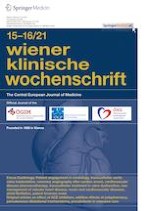11.01.2021 | original article
A clinical retrospective study of percutaneous dilatational tracheostomy without guide wire for critically ill patients
Erschienen in: Wiener klinische Wochenschrift | Ausgabe 15-16/2021
Einloggen, um Zugang zu erhaltenSummary
Objective
This study aimed to introduce a novel tracheostomy method, the non-guide-wire percutaneous dilatational tracheostomy (NGPDT) technique, and evaluate its effectiveness for critically ill patients undergoing neurosurgery under special conditions.
Methods
The clinical data of 48 critically ill patients who underwent NGPDT under special conditions with controlled steps were analyzed retrospectively. The patients’ demographic, preoperative state of illness, and diagnosis data were collected. Moreover, their intraoperative and postoperative variables were accessed, e.g., operation times, bleeding, saturation of pulse oxygen (SPO2), and early and late complications related to NGPDT.
Results
The mean patient age was 47.7 ± 13.7 years. The mean GCS (Glasgow Coma Scale) was 8.1 ± 2.9, and the mean BMI (Body Mass Index) was 25.2 ± 5.6. There were 38 patients with an endotracheal tube. The mean duration of onset to NGPDT was 4.0 ± 1.3 days. The mean operation time was 4.2 ± 1.9 min. There were 41 patients with mild intraoperative bleeding, 5 with moderate bleeding, and 2 with severe bleeding as well as 46 with mild postoperative bleeding and 2 with moderate bleeding. Additionally, 41 patients required complete extubation after NGPDT. The mean duration of incision healing was 4.8 ± 3.1 days. There was 1 patient with a decrease of SPO2 ≥ 10%. Three patients presented with a transient violent cough at the primary tracheostomy stage; however, no patients suffered from pneumothorax, subcutaneous emphysema, false passage, or surgery-related death during this procedure.
Conclusion
Overall, NGPDT with controlled steps is a fast, safe, and microinvasive procedure. It mildly stimulates the trachea with a low rate of complications.
Anzeige
